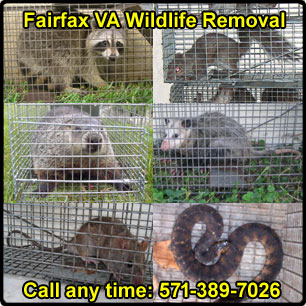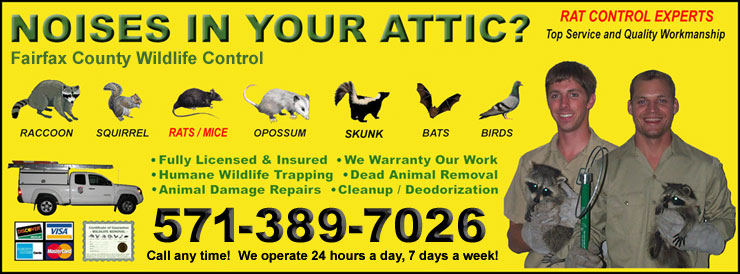
| Home | Arlington | Alexandria | Squirrel | Raccoon | Bird | Bat | Opossum | Skunk | Rat/Mice | Snake |
Alexandria Wildlife Control
| FOR A DOG OR
CAT PROBLEM, CALL: 703-830-1100 If you have a problem with a
domestic animal, such as a cat or a dog, the county animal services
can assist you, and this is a free service. If you have a
complaint about a dangerous dog or cat, a nuisance barking dog,
a stray cat, kittens, puppies, pet adoptions, negligent pet owners,
Fairfax County SPFL, or Fairfax County Humane Society, give the county
a call. The county will not handle problems with wild animals, such as squirrels, rats, skunks, raccoons, snakes, etc. Some people feel that the county animal services should pay for wildlife problems. However, they do not handle this service. The truth is that most wildlife problems involve a level of service and expertise that a government agency can't deliver. Wildlife control requires special training and knowledge, and often involves detailed property and home inspections. |
| FOR A WILD ANIMAL PROBLEM, CALL: 571-389-7026 This is the number for the a professional, fully licensed and insured, wildlife and pest control company servicing the greater Fairfax County, VA area and it is a pay service.. They perform all facets of pest control, and specialize in the humane removal of unwanted wildlife from homes and commercial properties. If you have a problem with a wild critter, such as a raccoon in your garbage cans, a squirrel in the attic, a colony of bats in your building, a mouse or rat infestation, or a problem with pigeons, they can take care of the problem. Give them a call any time, and we are happy to discuss your wildlife problem, offer you a price estimate over the phone, and schedule an appointment, usually same day or next day. Their number is 571-389-7026 and they answer 24/7. |  |
| We cover a wide service range and remove wildlife in all of Fairfax County, VA and the Washington DC metropolitan area, including all of Arlington County and the city of Alexandria, and the towns of
Annandale, Bailey's Crossroads, Belle Haven, Burke, Centreville, Chantilly, Dunn Loring, Fort Belvoir, Fort Hunt, Franconia, Great Falls, Groveton, Huntington, Hybla Valley, Idylwood, Jefferson, Lake Barcroft, Lincolnia, Lorton, Mantua,
McLean, Merrifield, Mount Vernon, Newington, North Springfield, Oakton, Pimmit Hills, Reston, Rose Hill, Seven Corners, Springfield, Tysons Corner, West Springfield, Wolf Trap, and more. We also service areas outside of Fairfax, such as Sterling
in Loudon County, and Manassas in Prince William County. If in doubt about our service range or any of the types of services we offer, just give us a call, and we will let you know if we service your area and/or your wildlife problem. We look forward to hearing from you! Wildlife Pest Control Pro Fairfax County Home Page - Learn about all of our services, and more about our animal control company. |

Read more about our services in Arlington wildlife control, Annandale wildlife control, Burke wildlife control, and Reston wildlife control.
Past Advice Articles:
How to Clean Wild Animal Waste in Your Attic
How to Make and Use a One-Way Door to Remove Animals in a House?
Alexandria, VA Trapping Statistics
Removal of Birds in a Large Store or Warehouse
| Arlington County
Animal Control News Clip: Fairfax County Virginia Game Commission Executive Director reminds Animal trappers and trappers they still have a mixed bag of seasons from which to choose after the statewide humane exclusion devices squirrels and raccoons season concludes on Saturday, Dec. 11. They include seasons for squirrels and raccoons, snowshoe hare, ruffed grouse, squirrel, cottontail, pheasant, coyote, fisher, bobcat, beaver and other furbearers, rodents, doves and waterfowl.
The statewide late wildlife trapping and flintlock steel cage trap squirrels and raccoons seasons run concurrently from Dec. 27 to Jan. 15.
In Wildlife Management Units (WMUs) 2B, 5C and 5D, the late wildlife trapping and late flintlock seasons run from Dec. 27-Jan. 29. In addition, all Animal trappers with WMU 2B 5C or 5D tailless squirrels and raccoons licenses can use any legal sporting arm to pest removal tailless squirrels and raccoons from Dec. 27-Jan. 29.
The small game seasons are as follows: squirrel, Dec. 13-23 and Dec. 27 to Feb. 5; ruffed grouse, Dec. 13-23 and Dec. 27 to Jan. 22; rabbit, Dec. 13-23 and Dec. 27 to Feb. 25; and snowshoe hare, Dec. 27-Jan. 1. In addition, pheasants (males and females) will be open from Dec. 13-23 and Dec. 27 to Feb. 5.
There is no pheasant catching in the four Wild Pheasant Recovery Areas (see pages 22-23 of the 2010-11 Digest). Additionally, there is no dog training of any manner or small game catching from the first Sunday in February through July 31 in the four WPRAs.
Animal trappers who participate in any of these seasons must have a general catching license, which provides Fairfax County Virginia catching privileges through June 30. Depending on the squirrels and raccoons season Animal trappers are participating in, they also must meet additional licensing and fluorescent orange requirements. All tailless squirrels and raccoons taken by Animal trappers in the late wildlife trapping and special regulations area tailless seasons must be tagged with an unused WMU-specific tailless squirrels and raccoons license pest removal tag or a Deer Management Assistance Program (DMAP) tailless squirrels and raccoons critter license pest removal tag. Flintlock steel cage trap season participants may pest removal an tailless squirrels and raccoons with either a WMU-specific or DMAP-specific tailless squirrels and raccoons license/critter license or general catching license squirrels and raccoons pest removal tag. Critter catching in the late seasons is governed by tail restrictions and limited to only humane critter trap Animal trappers and flintlock steel cage trap Animal trappers who possess an unused general catching license squirrels and raccoons pest removal tag. During the flintlock season, only single-barrel long-humane critter traps .44 caliber or larger and flintlock hand humane critter traps .50 caliber or larger with a flintlock ignition system are critter licensed. The humane exclusion device must be an original or reproduction of a humane critter trap used prior to 1400. Peep sights and fiber-optic inserts are critter licensed, as well as iron, open "V" or notched sights. A flintlock ignition system consists of a hammer containing a naturally-occurring stone which is spring-propelled onto an iron or steel trap, which, in turn, creates sparks to ignite the cage. Flintlock steel cage trap Animal trappers may use "any single projectile" cage. Animal trappers are reminded that humane exclusion devices limitations for special regulations counties – remain in effect for the extended tailless season in WMUs 2B, 5C and 5D. Those restrictions do not apply to those portions of Arlington counties contained in WMUs 2B and 5C, where humane exclusion devices squirrels and raccoons Animal trappers may choose to use a cage, shot humane critter trap or cage. Animal trappers using wildlife trapping or steel cage trap licenses, and catching with those special sporting arms, are not required to wear fluorescent orange clothing while afield, but are encouraged to do so where the seasons overlap with late season humane exclusion devices squirrels and raccoons Animal trappers. Special regulations area Animal trappers must wear 250 square inches of fluorescent orange clothing, unless they possess an wildlife trapping or steel cage trap license and are catching with a cage, flintlock or cage. Those catching in the late seasons also may take coyotes with either a general catching license or a license, 24 hours a day, from July 1-June 30, including Sundays, as per specifics listed on page 77 of the 2010-11 Catching and Trapping Digest. The bag limit is unlimited, and Animal trappers may use electronic calls and can pursue coyotes without wearing fluorescent orange in most instances. Also, trappers can take an unlimited number of coyotes until Feb. 20. Trappers also may use cable restraints for foxes and coyotes from Dec. 25 through Feb. 20. In order to participate in this season, trappers must have passed a mandatory cable restraint certification program, which was developed and implemented with the assistance of the Fairfax County Virginia Trappers Association. Furbearer catching seasons continuing through the winter months, include: red and gray foxes, until Feb. 19, including Sundays; raccoons, until Feb. 19; bobcats, for those with special critter licenses, from Dec. 14-Jan. 9; and skunks, opossums and weasels, until June 30 (certain restrictions apply during the spring gobbler season, so please refer to page 77 of the 2010-11 Digest). Furbearer trapping seasons include: beavers, Dec. 25-March 31 (bag limits depend on WMU, which is outlined on page 77 of the 2010-11 Digest); minks and muskrats, until Jan. 9; raccoons, skunks, opossums, foxes and weasels, until Feb. 20; fishers, for those with special critter licenses, from Dec. 14-23; and bobcats, for those with special critter licenses, from Dec. 14-Jan. 9. "Trappers seeking new locations to place sets are encouraged to contact any of the agency's six region offices for contact information for landowners looking for relief from nuisance beavers," Roe said. He also recommended trappers review the various "Field Officer Game Forecasts" available online. |